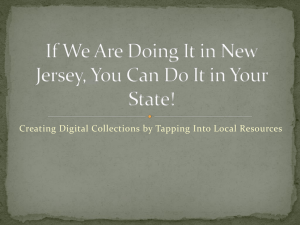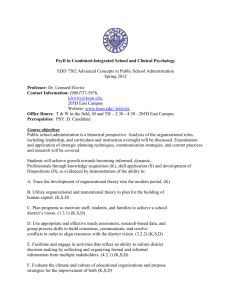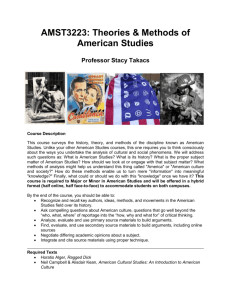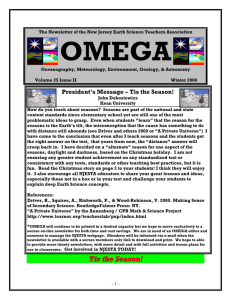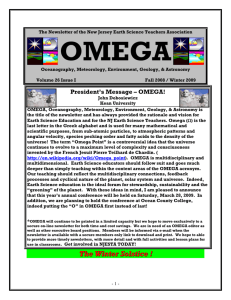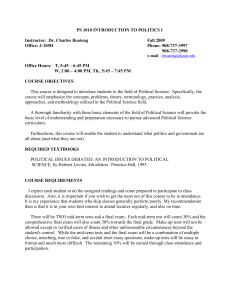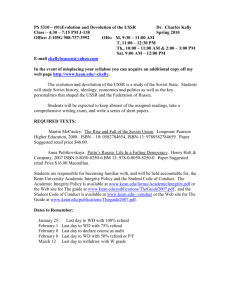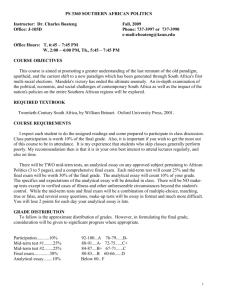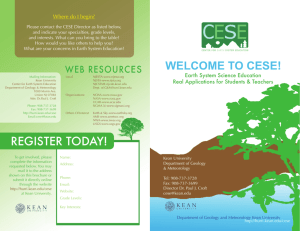Fall 2009
advertisement
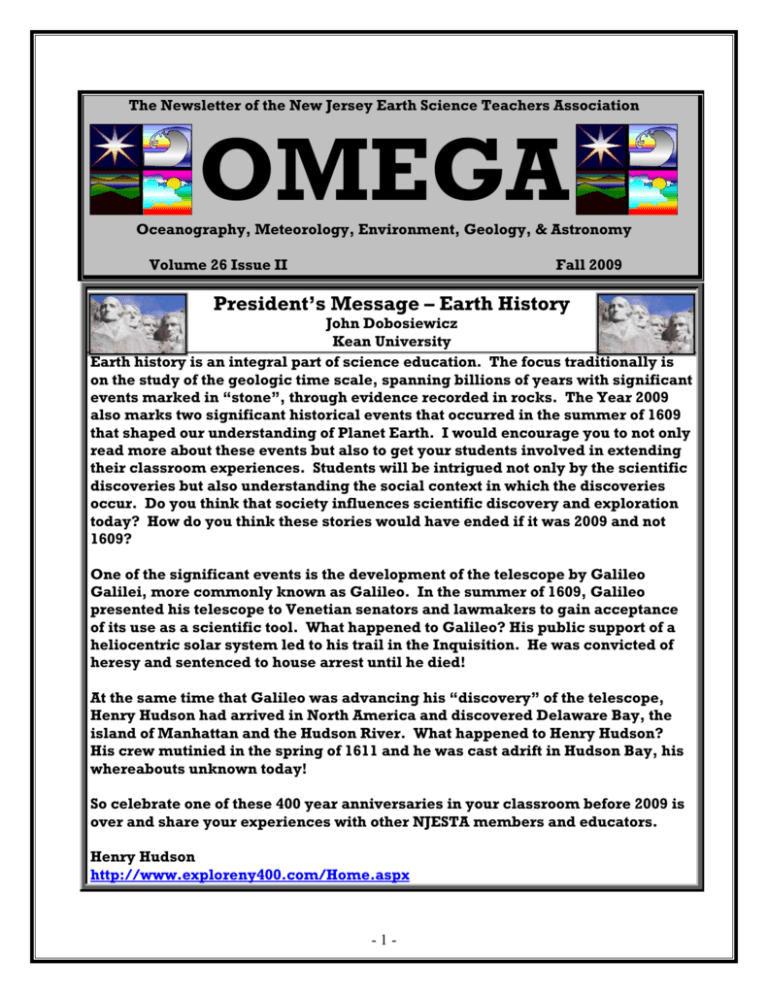
The Newsletter of the New Jersey Earth Science Teachers Association OMEGA Oceanography, Meteorology, Environment, Geology, & Astronomy Volume 26 Issue II Fall 2009 President’s Message – Earth History John Dobosiewicz Kean University Earth history is an integral part of science education. The focus traditionally is on the study of the geologic time scale, spanning billions of years with significant events marked in “stone”, through evidence recorded in rocks. The Year 2009 also marks two significant historical events that occurred in the summer of 1609 that shaped our understanding of Planet Earth. I would encourage you to not only read more about these events but also to get your students involved in extending their classroom experiences. Students will be intrigued not only by the scientific discoveries but also understanding the social context in which the discoveries occur. Do you think that society influences scientific discovery and exploration today? How do you think these stories would have ended if it was 2009 and not 1609? One of the significant events is the development of the telescope by Galileo Galilei, more commonly known as Galileo. In the summer of 1609, Galileo presented his telescope to Venetian senators and lawmakers to gain acceptance of its use as a scientific tool. What happened to Galileo? His public support of a heliocentric solar system led to his trail in the Inquisition. He was convicted of heresy and sentenced to house arrest until he died! At the same time that Galileo was advancing his “discovery” of the telescope, Henry Hudson had arrived in North America and discovered Delaware Bay, the island of Manhattan and the Hudson River. What happened to Henry Hudson? His crew mutinied in the spring of 1611 and he was cast adrift in Hudson Bay, his whereabouts unknown today! So celebrate one of these 400 year anniversaries in your classroom before 2009 is over and share your experiences with other NJESTA members and educators. Henry Hudson http://www.exploreny400.com/Home.aspx -1- Galileo Galilei http://www.astronomy2009.org/static/organisation/galileo_resources_guide.pdf For more on the International Year of Astronomy project: http://www.astronomy2009.org/ *OMEGA will continue to be printed in a limited capacity but we hope to move exclusively to a secure on-line newsletter for both time and cost savings. Members will be informed via e-mail when the newsletter is available with a secure members only link to download and print. We hope to able to provide more timely newsletters, with more detail and with full activities and lesson plans for use in classrooms. Get involved in NJESTA TODAY! Why do we have to learn Earth Science? (by Missy Holzer) The first day of the school year can set the tone for the entire year, and we as Earth Science teachers have the best resources to ensure a terrific opening to the new school year. We have access to images and animations of exciting events, fascinating phenomenon, and perplexing puzzles in the Earth Sciences. We can stop our students in their tracks as they ask “why do we have to learn Earth Science?” by using video clips like “Why Earth Science” from AGI and available on the AGI website http://www.agiweb.org/education/resource/index.html and on YouTube. This free 7 minute video will give your students a taste of what’s in store for them for the school year, and will entice them to choose a career in one of the many fields of Earth Science. They will be captivated by the footage and the message it has that Earth Science includes everything everywhere! Best Wishes for a new school year! CESE: Providing Resources for Learning in ESS (by Paul Croft) The Center for Earth System Education has established a collection of websites designed to provide resources for training and learning in Earth System Science for all sorts of communities. The main CESE site (http://hurri.kean.edu/cese/), hosted by the Kean University Department of Geology and Meteorology (http://hurri.kean.edu/) provides links to stakeholder white papers on environment and earth system science teaching, shared curricular materials from the classroom, real-time and archive data access (http://hurri.kean.edu/kuweather/index.html and http://hurri.kean.edu/~keancast/), and safety information and links. Presentations and materials from the 2009 NJESTA Conference are also available for use and comment and additional contributions that may be shared with others are requested. The Center is assisted by undergraduate majors in the department who also provide presentations to small groups and host tours of the campus facilities. -2- Check out the new website for the Center for Earth System Education at Kean University http://hurri.kean.edu/~cese Schedule a show at the Kean University Alumni Planetarium located in the Science Building Third Floor C-330 Featuring a digital star lab projector ! (used to make the background on this page) Presentations include: The Night Sky Seasons Phases of the Moon Planets & Moons in the Solar Systems Stellar Evolution Galaxies & Black Holes! Tell us what topic you are teaching and we’ll create a show to suit your needs. Objectives and assessments provided! Contact: Dr. John Dobosiewicz (908) 737-3696 or jdobosie@kean.edu A Fountain of Ideas – ESPRIT (by Rich Pearson) One of the primary ways I have been able to grow both as an Earth Science teacher, but also grow in my content knowledge has been from an e-mail list called ESPRIT. While it is composed mainly of New York Earth Science teachers, it does have a smattering of teachers from Virginia, New Jersey, Texas, other states, and a few foreign countries. I cannot recommend an easier way of staying current with Earth Science events, and it’s a great way of finding and sharing resources with other teachers. Regular contributors mostly teach high school, or junior high, but also include some college-level professors (who chime in mostly with great explanations!). -3- To sign up, go to this website: http://external.oneonta.edu/mentor/listserv.html, type in your e-mail address, and select ESPRIT. Just know that list activity ranges from 20 to 50 e-mails a day; if you would rather not check it every day, you can either create an e-mail address just for list activity, or access the list archives, also available at the address above. ESPRIT – over 1,000 teachers strong! NASA Blast Back to School (by Missy Holzer) As you get ready for the new school year, consider adding a little space to your class. NASA offers educational resources for use with kindergarten through college, as well as resources for the informal education community. Many of NASA’s educational products are quick and easy to find on the NASA Web site. Visit the NASA Blast Back to School page to find educational resources and NASA events taking place in your area. From the site you can find information relating to the following topics: • • • • • • Bring NASA Missions Into Your Classroom Bring NASA to Your School and Neighborhood Attend a NASA Educator Workshop Current Opportunities for Educators and Students NASA Resources for Your Classroom Especially for Students For more information, visit the Blast Back to School page: http://www.nasa.gov/audience/foreducators/blast-back-to-school.html INSTITUTE FOR URBAN ECOSYSTEM STUDIES at KEAN UNIVERSITY The mission of the Institute for Urban Ecosystem Studies (IUES) is consistent with the overall mission of Kean University and its goal is to prepare students to think critically and creatively so that they can adapt to changing social, economic and technological conditions, particularly as they pertain to urban ecosystems. -4- The mission statement of IUES emphasizes that IUES provides a setting conducive to interdisciplinary discourse that leads to investigations of both the basic and applied aspects of urban ecology. By encouraging community-based land stewardship and environmental education and engaging in research in the natural, applied and health sciences, IUES aims to further understand and foster the biodiversity of urban environmental systems. The New Jersey Astronomy Center (by Theresa Moody) Do you want to do a better job teaching Science this year? Are you unsure of how to teach some of the challenging topics in Science, such as Gravity and Newton’s Laws? Are you wondering how you can address the revised New Jersey Physical Science and Earth Systems Science standards in your class? The New Jersey Astronomy Center (NJACE) at Raritan Valley Community College has developed a wide range of teacher workshops to help K-12 teachers gain a better understanding of concepts in astronomy and physics and how to teach them effectively. The presenters, Dr. Wil van der Veen and Theresa Moody, are recognized as experts in science content and effective science instruction. Teachers walk away with lots of resources, an increased understanding of the content and how to teach it effectively, as well as a variety of hands-on inquiry-based activities they can do tomorrow in their classroom. All workshops are held at Raritan Valley Community College, located near Bridgewater. For more detailed information and to obtain registration forms, see http://www.raritanval.edu/planetarium/teachinginstitute.htm or contact Theresa Moody at 908-526-1200 x 8942 or email tmoody@raritanval.edu. Thursday, December 3 (9am-3pm) Register by Thursday, November 19 Is there life out there? An Astrobiology workshop for teachers – Grades 5-12 Astrobiology is an exciting, interdisciplinary field of study that includes the search for habitable environments and the consideration of where life might exist in our solar system and beyond. The revised New Jersey Science Process standards ask teachers to make meaningful connections between concepts across content areas. Learn how you can use Astrobiology as a way to connect astronomy, biology, physics, chemistry and geology as you explore the possibilities of life elsewhere, consider the conditions under which life can develop and thrive, and examine the properties of stars that could have planets harboring life. Cost: Only $25 due to grant support! (5 PDUs) Tuesday, December 8 (9am-3pm) Register by Tuesday, December 3 Gravity 1: Gravity and Orbits in the Solar System – Grades 5-12 This workshop engages teachers in low-cost, hands-on, inquiry-based activities relating to Gravity, Newton’s Laws of Motion, the motion of objects within the solar system and new, cost-effective ways for a spacecraft to travel to the Moon. Teachers will gain an improved understanding of these topics, while simultaneously learning about activities they can easily integrate into their own classrooms. Cost: $125 (5 PDUs) -5- National Earth Science Week 2009 (by Missy Holzer) National Earth Science Week is around the corner! The celebration will take place October 11-17, 2009 and this year’s theme is “Understanding Climate.” Not sure what to do for that week? Go to National Earth Science Week Homepage (http://www.earthsciweek.org) and you will find numerous ideas related to this year’s theme. You may also purchase an Earth Science Week kit for $6.95 which is filled with posters and resources to use during the celebration and the rest of the year. Don't forget to go the Windows to the Universe website (http://www.windows.ucar.edu) for additional teacher friendly resources on climate change. And close to home, how about taking your students to the NJ State Museum in Trenton to explore the “Rising Tide: Climate Change in New Jersey” exhibit. (http://www.state.nj.us/state/museum/see_rising_tide.htm) The PSE&G funded exhibit will be at the museum until January 24, 2010. ESLab Share-a-Thons (by Rich Pearson) Ok, NJESTA members, here’s an idea for you! Have a great activity that you’d like to see others use? Are you the only Earthie in your district? Want to get some fresh ideas, and network outside your district? Then come to a share-a-thon! Formerly called “ES-Lab”, I’ll host the first gathering at Bloomfield, we’ll have another at Kean University in January (thanks, John!), and hopefully we can get a couple of other folks to step up and host – one from Central or Western Jersey, and one from South Jersey would be great. I’ve been part of sharing sessions through STANYS (Science Teachers’ Association of New York State) Westchester section for three years now, and it is a great way to meet others outside of your district, and to get different ideas. So, what I’m envisioning is….four meetings a year, about an hour or two in length, hosted by a NJESTA member. Non-members can attend, but we hope they “do the right thing” and join by their second meeting. If you’re planning on coming, or are interested in setting a date for hosting a meeting yourself, e-mail me at either CASAJersey@aol.com, or rpearson@bloomfield.k12.nj.us. First NJ ESLab Share-a-thon: Wednesday, October 21, 2009, 4:00pm Bloomfield High School, Room B463 160 Broad Street Bloomfield, NJ 07003 -6- RUTGERS GEOLOGY MUSEUM The Rutgers University Geology Museum, which is open to the public, features exhibits on geology and anthropology, with an emphasis on the natural history of New Jersey. To arrange a group tour of the Geology Museum, please contact Aly Busse at (732) 932-7243, or museum@rci.rutgers.edu. There is no charge for admission and the museum even has a small gift/rock shop! Information: Contact Aly Busse or Lauren Neitzke-Adamo at (732) 932-7243 or museum@rci.rutgers.edu Please visit our website at: http://geologymuseum.rutgers.edu The Museum is located in Geology Hall; 85 Somerset Street, New Brunswick; entrance is through the iron gate on the corner of George and Somerset Streets. Educators who attend Museum presentations can receive credit toward their professional development requirements. The Geology Museum is registered as a Provider with the NJ Department of Education. Become a NESTA member for $10! (by Missy Holzer) The National Earth Science Teachers Association is the country’s premier K-12 Earth Science teachers association offering member benefits of access to a member enhanced website (www.nestanet.org), monthly E-news, quarterly journal, and extensive outreach at all the NSTA conferences and local and regional events. They are at the pulse of Earth Science education and inform policy makers about the importance of Earth Science education at all grade levels. Now you can join this dynamic organization for only $10 per year! Their E-membership affords you all the benefits of their standard membership, except their journal The Earth Scientist is delivered electronically. Visit the NESTA website and join NESTA and become part of a national network of Earth Science teachers all dedicated to quality Earth Science education! Visit the Dynamic Earth Exhibit Live or virtually! http://newarkmuseum.org Or take your students to a planetarium show Go to Collections Æ Natural Sciences Æ Dynamic Earth or Planetarium Earth Science Student of the Year and Earth Science Teacher of the Year Awards If you would like to make a nomination for either of these awards, see www.njesta.org for more details, or e-mail Theresa Moody at tmoody@raritalval.edu. We that this will be a very competitive school year! -7- Project ASTRONOVA: Bringing Astronomers into NJ Classrooms for 12 years! (by Theresa Moody) Wouldn't it be great if you had your own personal astronomer who would visit your classroom several times during the year? Project ASTRO is a National Program that creates long-term partnerships between astronomers and teachers. The New Jersey Astronomy Center (NJACE) hosts the New Jersey Project ASTRO NOVA program. Now in its twelfth year, Project ASTRO NOVA has already trained over 250 teachers, partnered them with over 120 astronomers, and reached over 50,000 New Jersey students. Each year it partners K-12 teachers with visiting volunteer astronomers who have an interest in working with local schools and community organizations. The astronomer is a resource for the teacher and provides students with the unique opportunity to interact with a scientist. An important part of the program is that astronomers and teachers are trained before they start working together as partners in the classroom. At the training, teachers meet their astronomer and experience together how students can learn astronomy through an inquiry-based approach that meets State Science Process and Astronomy Content Standards. All participants receive a copy of The Universe at Your Fingertips with over ninety of the very best inquiry-based activities in astronomy as well as a variety of astronomy resources. During the workshop, partners develop a strategy for working together, in and out of the classroom, and start planning their astronomy lessons and the astronomer’s first visit. During the school year, the astronomer commits to at least four visits. During these visits they co-teach astronomy with the classroom teacher. The training workshop is scheduled for FridaySaturday, January 22-23, 2010 at Raritan Valley Community College. Teachers will receive 12 PDU’s. The deadline for applications is November 13, 2009. The fee for the Training Workshop is $400. Scholarships may be available, please email Theresa Moody for more information. For more information about Project ASTRO or other NJACE astronomy workshops, call Theresa Moody at 908-526-1200 x 8942. Application forms and more information can be obtained at www.raritanval.edu/planetarium/teachinginstitute.htm or email tmoody@raritanval.edu Earth Science Education at the 2009 NJ Science Convention (by Missy Holzer) The New Jersey Science Convention sponsored by the NJ Science Teachers Association and NJ Science Education Leadership Association is coming up October 13th and 14th in Somerset NJ. There are numerous Earth Science related presentations and workshops on both days making it well worth the professional development day. The searchable PDF program can be found at http://www.njsc-online.com. Click on the “Program” bullet in the middle of the page, select the day, and scan through the listing for “ES” or “ENV” for Earth Science and Environmental Science related programs. While at the convention, visit the NJESTA booth in the Exhibit Hall to update your membership and to pick up our give-aways. See you there! -8- Events of Interest to the ES Teacher Calendar Sept. 19-20 Mid-Hudson Valley Mineral & Gem Show (Rhinebeck, NY) http://mhvgms.org/annual_show/index.html Sept. 25-27 NYS Geological Association Annual Meeting (SUNY, New Paltz, NY) http://www.nysga.net/Annual_Meeting.html Sept. 26 Earth 2 Class – GIS Data Visualization (LDEO, Palisades, NY) http://www.earth2class.org/ Sept. 26-27 Franklin-Sterling Hill Mineral & Gem Show (Franklin, NJ) http://sterlinghillminingmuseum.org/visitor/schedule.php Oct. 8 Hudson River Snapshot Day (Jersey City, NJ to Troy, NY) http://www.ldeo.columbia.edu/edu/k12/snapshotday/ Oct. 9-10 Geological Society of NJ Annual Conference (Pomona, NJ) http://www.ganj.org/2009/2009mtg.htm Oct. 11-17 Earth Science Week (Everywhere!) http://www.earthsciweek.org/index.html Oct. 13-14 NJ Science Convention (Somerset, NJ) http://www.njsc-online.com Oct. 17-18 Bristol Gem & Mineral Club 37th Annual Show (Bristol, CT) http://bristolgem.org/?page_id=15 Oct. 21 ESLab Share-a-Thon at Bloomfield High School (Bloomfield, NJ) http://www.bloomfield.k12.nj.us Oct. 24 Earth 2 Class – Topic TBA (LDEO, Palisades, NY) http://www.earth2class.org/ Oct. 31- Nov. 3 114th Annual STANYS Convention (Rochester, NY) http://www.stanys.org/aboutconf.htm Nov. 5-6 NJEA Convention (Atlantic City, NJ) http://www.njea.org/pd/default.aspx?z=1334 Nov. 7-8 Tuscarora Lapidary Society Gemarama Show (Exton, PA) http://www.lapidary.org/gemarama/gemarama_main.htm Nov. 7-8 New York City Fall Gem & Mineral Show (New York, NY) http://www.excaliburmineral.com/ Nov. 12 STANYS-Westchester-ES Meeting @ A. Hamilton HS (Elmsford, NY) http://web.me.com/rose.sanders/Site/Westchester_STANYS.html Nov. 21 Earth 2 Class – Acidification of Ocean Water (LDEO, Palisades, NY) http://www.earth2class.org/ Dec. 3 NJACE – Astrobiology Workshop (RVCC, Branchburg, NJ) http://www.raritanval.edu/planetarium/teachinginstitute.htm Dec. 8 NJACE – Gravity & Orbits in the Solar System (RVCC, Branchburg, NJ) http://www.raritanval.edu/planetarium/teachinginstitute.htm Dec. 12 Earth 2 Class – 100th Program Celebration (LDEO, Palisades, NY) http://www.earth2class.org/ Jan. 14 STANYS-Westchester-ES Meeting @ WPMS (White Plains, NY) http://web.me.com/rose.sanders/Site/Westchester_STANYS.html Jan. 22-23 Project ASTRO NOVA Training Workshop (RVCC, Branchburg, NJ) http://www.raritanval.edu/planetarium/teachinginstitute.htm Jan. 23 Earth 2 Class – Using GeoMapApp (LDEO, Palisades, NY) http://www.earth2class.org/ Jan. (Date TBD) ESLab Share-a-Thon @ Kean University (Union, NJ) http://www.njesta.org Compiled by Rich Pearson -9- Got Dates? Send to CASAJersey@aol.com with “Calendar” as the subject Editor’s Note – (By Rich Pearson) I hope you enjoyed and have received some value from reading this installment of OMEGA, my first as editor. I hope that you will feel free to share article ideas, upcoming events, and your work with us, so that we can share it with all of you. Please send your ideas and dates to me at either my school address (rpearson@bloomfield.k12.nj.us), or preferably to my personal address (CASAJersey@aol.com). For those of you that don’t know me, I’m starting my sixth year as a teacher, and I’ve spent all of it at Bloomfield High School. I was an alternate route teacher, and came to Earth Science as an interest, rather than via effective training. In an effort to strengthen my content knowledge, I’ll be spending this school year getting ready to take the GRE and saving money to start a MS in GeoScience at Montclair State University, officially, I hope, in the Fall of 2011, as I have to take two undergraduate prerequisite courses in the 2010-2011 school year. - 10 - NJESTA stamp Dept. of Geology & Meteorology Kean University Union, NJ 07083 label NJESTA EXECUTIVE BOARD 2009 President John Dobosiewicz Kean University jdobosie@kean.edu Past President: John Dobosiewicz President Elect: Vacant Officers Secretary & Membership Angela Best Applegarth MS Monroe Township abest@monore.k12.nj.us Treasurer Christine Cirtain Toms River South HS cgirtain@trschools.com Members-At-Large Missy Holzer – NSTA, NESTA, & NJSTA Liaison Hope Kowalski-Porta - Constitution Chair Kinnelon H.S. Chatham H.S. mholzer@monmouth.com kowalskih@optonline.net Susan Petroulas - Educational Outreach Charlie Murphy - Webmaster Newark Museum Kean University spetroulas@newarkmuseum.org cmurphy@kean.edu Paul Croft - Center for Earth System Education Christopher Roemmele (former president) Parsippany Hills HS at Kean University pcroft@kean.edu croemmele@pthsd.k12.nj.us Mark Worobetz (former president) Theresa Moody – Awards Project Astro RVCC Sparta HS woro@nac.net tmoody@raritanval.edu Richard Pearson – OMEGA Editor Bloomfield HS casajersey@aol.com - 11 -
